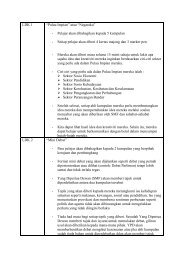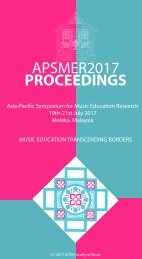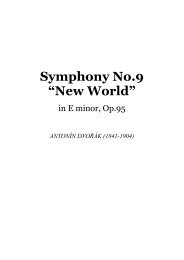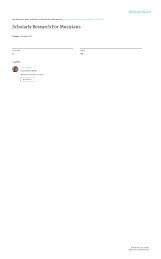APSMER2017 PROCEEDINGS
You also want an ePaper? Increase the reach of your titles
YUMPU automatically turns print PDFs into web optimized ePapers that Google loves.
Proceedings of the 11th Asia-Pacific Symposium for Music Education Research<br />
(APSMER 2017) 19th to 21st July 2017, Melaka MALAYSIA<br />
this dance ranges from a moderate to a fast pace. The Zapin Melayu is an<br />
adaptation of the original Zapin Arab which came through during the trade<br />
times of Malacca, and has gone through adaptations and assimilations of the<br />
two cultures, from both religious and cultural perspectives. (Mohd Anis Md<br />
Nor, 2009, p.36). The Zapin has many variations which originated from<br />
various parts of Malaysia, including:<br />
• Mersing: Zapin Tenglu and Zapin Pulau;<br />
• Muar: Zapin Lenga;<br />
• Johor Bahru: Zapin Pekajang; Zapin Budi (Johor, Pahang,<br />
Selangor)<br />
• Batu Pahat: Zapin Koris;<br />
• Pontian: Zapin Parit Mustar and Zapin Seri Bunian<br />
(Mohd Anis Nor, 2001, p.65-71)<br />
The Zapin dance is considered to be a part of the Malay culture and is<br />
performed mainly for entertainment purposes. According to Mohd Anis Md<br />
Nor (2006, p.35), “Like many other Malay folk and social dance traditions,<br />
Zapin owes its existence to the processes of intercultural and cross-cultural<br />
borrowings through the ages”.<br />
Instrumentation and Musical Characteristics of Zapin<br />
Zapin dance performances are accompanied by a group of instruments,<br />
including gambus, violin, flute, accordion, marwas or rebana, and bass<br />
guitar. Zapin music has a specific form, including an introduction, middle<br />
and final section. The introduction or Taksim is an improvised solo played<br />
mainly by gambus (or accordion, violin or flute). The middle main melodic<br />
section, Kopak, is based on distinct rhythmic patterns played by a few drum<br />
players (marwas or rebana) in an interlocking style. The final section or<br />
coda, named Wainab or Tahtim, uses the Kopak melodic phrase. (Matusky &<br />
Tan, 2004; Mohd Anis Md Nor, 2009). In modern times, the Zapin dance is<br />
performed in different versions with a wide variety of improvisations and<br />
includes accompanying instruments such as the violin, flute, gambus,<br />
accordion (melodic and harmonic lines) and traditional percussion like two<br />
rebana and tambourine (rhythmic pattern).<br />
One of the most famous Zapin pieces is Pantun Budi, which is a<br />
traditional song, made famous by the late Tan Sri S. M. Salim. A‘Pantun’ is<br />
a Malay poetic form based on a theme or subject (tajuk) and ‘Budi’ means<br />
‘good deeds’ (Ho, 2015). For many centuries this dance was performed only<br />
by men, in compliance with religious concepts, but in modern times it also<br />
includes women. The time signature is 4/4 and contains melody, harmony<br />
and a rhythmic accompaniment.<br />
The middle section of this Pantun Budi contains two parts, including<br />
the chorus and verse. These sections are connected with a bridge consisting<br />
of a strong, rhythmic pattern called Kopak (pak kopak kopak kopak). Zapin<br />
is most commonly based on a hexatonic scale and/or a heptatonic scale<br />
pattern. Chye (2016, p.219). This creates an impression that the music is<br />
hovering between modes as well as in a diatonic key”. According to Chye<br />
(p.219), the rhythmic form in Zapin is based on "quaver-two semiquaversquaver-quaver-quaver-quaver<br />
and crotchet". The ornamentations that<br />
embellish the melody and improvisations create an exclusively Malay<br />
character, and are included in the performance to give the melody variety, to<br />
avoid a monotonous outcome.<br />
29








